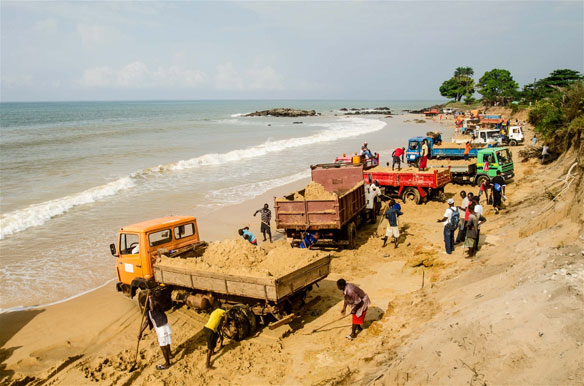
By Jakob Villioth.
Sand has by now become the most widely consumed natural resource on the planet after fresh water. [1] The annual world consumption of sand is estimated to be 15 billion tons, with a respective trade volume of 70 billion dollars.
Over the last two centuries sand has become a vital commodity for our modern economies:
Most of our houses, skyscrapers and bridges are made with ferro-concrete which is two-thirds sand (plus cement, water and gravel). 200 tons of sand are needed to build a medium-sized house, 1km of highway requires 30.000 tons of sand. Especially in Asia and the Arab states the hunger of the construction industry is ever-growing -cement demand by China has increased exponentially by 437.5% in 20 years, while use in the rest of the world increased by 59.8%.
High quality sand, or more precisely, silicon is needed to produce computer chips and microprocessors and we also use sand in detergents, cosmetics and many other products – yet, once sand has been transformed into concrete, the components are bound forever and are no longer available as resources.
Given the weight of sand and gravel (“aggregates”) in the material flows of many economies, it is not surprising that there are many conflicts on the extraction of such “innocent” materials. The conflicts are so widespread that in India they have given rise to a new term in the vocabulary of environmental injustices: “sand mafias”.
These sand mafias control large parts of the building industry through bribery and also does not hesitate to apply more brutal methods such as murdering activists; illegal business ties extend to the highest levels of police and government [2]. Illegal sand mining activities are particularly threatening water supply of local communities since river sand is a natural aquifer and its depletion also affects recharging of groundwater. In January 2014, Union minister of state for Commerce and Industry, stated that due sand mining in river beds, groundwater level or water table has dropped at an alarming rate, as a result some 18 lakh wells in the southern region have gone dry and water for agriculture purposes has become scarce [3]. More information on the current situation of sand mining in India can also be found in a paper by Martinez-Alier et al. recently published in our resources section.
The depletion of sand sources also leads to bizarre scenes in other parts of the world: in Morocco groups, which are called “sand-mafia” there as well, turn up at beaches with hundreds of people and take away entire beaches – the sand is then used to build huge hotel complexes for tourists, which actually come to Morocco to visit these very same beaches.
Until recently sand was extracted in land quarries and riverbeds; however, these inland resources have nearly been depleted so that extraction has shifted to marine and coastal aggregates mining.
Sand from deserts cannot be used for most purposes, as wind erosion over time forms round grains that do not bind well [4]. For most industrial uses, edged sand grains with a rough surface are needed, which stick together naturally. Desert sands, however, are usually fine- grained and of low shear strength –it does not even suit as material for the creation of artificial islands. Dubai, for example, used up all its suitable marine sand supplies for an artificial set of sand islands and, after these were exhausted, now has to import sand from Australia for continuing its building madness.
Most of the sand is by now extracted from the ocean floor – globally thousands of large boats are sucking up huge quantities of sand from the ocean floor in coastal areas like vacuum cleaners. As a result of currents, gravitation and movements of the waves, the gaps which were created by sand extraction are then filled by sand sliding in from surrounding areas and beaches. Due to this vicious cycle in Miami each year beaches have to be replenished with dredged-up sand to further provide tourists with its famous beaches.
In some extreme cases, the mining of marine aggregates has even changed international boundaries, such as through the disappearance of entire islands in Indonesia – since 2005 at least 24 small islands have disappeared as a result of erosion caused by illegal sand mining. Most of this sand is going to Singapore, which has expanded its surface area by 22% since the 1960s [5]. In response to this potentially heavy environmental toll many neighboring countries (Indonesia, Malaysia and Vietnam) have now banned exports of sand to Singapore, but this has only shifted the problem to countries such as Cambodia.
The conflicts caused by sand mining were for the first time brought to the attention of the general public through the documentary Sand Wars. Among many other outreach victories, the documentary inspired the United Nations Environment Programme (UNEP) to publish a Global Environmental Alert in March 2014 titled “Sand, rarer than one thinks”. In it, the authors state that “Formed by erosive processes over thousands of years, they [sand and gravel] are now being extracted at a rate far greater than their renewal”.
Despite the increasing rarity of sand, in the United States the price of sand has remained very stable, fluctuating from US$4.50 to US$6.7 a ton between 1910 and 2013 [4]. Because sand is still very cheap – sand itself is freely accessible; only extraction costs need to be covered – there is little or no incentive to induce a change in consumption.
The UNEP report therefore suggests striving for a better pricing and taxation of sand extraction so that alternative building materials to sand, such as recycled building material or glass, become economically viable. Further, the report explains that there is an urgent need for regulating sand extraction in both national and international waters. It states that “The implementation of a monitoring mechanism regarding global aggregate extractions and trade would […] raise this issue on the political agenda and perhaps lead to an international framework to improve extraction governance, as the current level of political concern clearly does not match the urgency of the situation”.
Our EJ atlas now includes some first cases of illegal sand mining, which can be found here.
References:
[1] UNEP Global Environmental Alert Service – Sand, rarer than one thinks (2014)
[4] Zhang G., Song J., Yang J., Liu X. (2006) Performance of mortar and concrete made with a fine aggregate of desert sand. Building and Environment 41, 1478–1481
[5] Global Witness report – Shifting sand (2010)


The project ENVJUSTICE has received funding from the European Research Council (ERC) under the European Union’s Horizon 2020 research and innovation programme (grant agreement No. 695446)